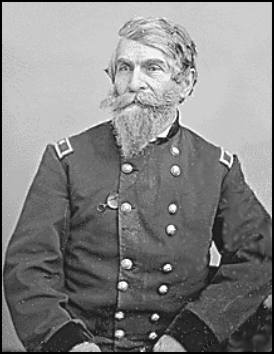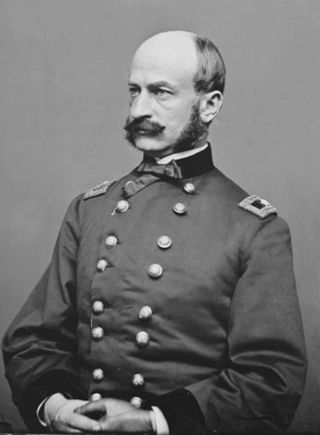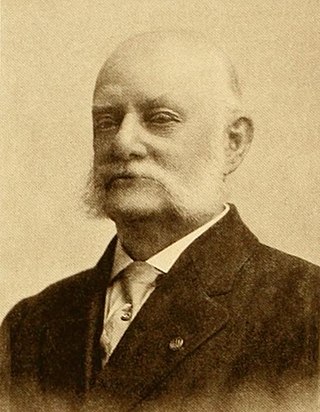Related Research Articles

Daniel Adams Butterfield was a New York businessman, a Union general in the American Civil War, and Assistant Treasurer of the United States.

Daniel Edgar Sickles was an American politician, soldier, and diplomat.

George Sears Greene was a civil engineer and a Union general during the American Civil War. He was part of the Greene family of Rhode Island, which had a record of distinguished military service to the United States. He first served in the Army from 1823 to 1836 after graduating second from his class at West Point. As a civilian, he was one of the founders of the American Society of Civil Engineers and Architects and was responsible for numerous railroads and aqueduct construction projects in the northeastern United States.

Andrew Atkinson Humphreys, was a career United States Army officer, civil engineer, and a Union General in the American Civil War. He served in senior positions in the Army of the Potomac, including division command, chief of staff, and corps command, and was Chief Engineer of the U.S. Army.

Baron Adolph Wilhelm August Friedrich von Steinwehr was a German-Brunswick army officer who emigrated to the United States, became a geographer, cartographer, and author, and served as a Union general in the American Civil War.

Alexander Stewart Webb was a career United States Army officer and a Union general in the American Civil War who received the Medal of Honor for gallantry at the Battle of Gettysburg. After the war, he was a prominent member of New York Society and served as president of the City College of New York for thirty-three years.

Samuel Kosciuszko Zook was a Union general during the American Civil War who was mortally wounded in action at the Battle of Gettysburg.
The 13th New Jersey Infantry Regiment was a Union Army regiment from New Jersey that fought in the American Civil War.

The 2nd Wisconsin Infantry Regiment was an infantry regiment that served in the Union Army during the American Civil War. It spent most of the war as a member of the famous Iron Brigade of the Army of the Potomac. It suffered the largest number of casualties as a percentage of its total enlistment of any Union Army unit in the war.

The 7th Ohio Infantry Regiment was an infantry regiment formed in northeastern Ohio for service in the Union Army during the American Civil War. It served in the Eastern Theater in a number of campaigns and battles with the Army of Virginia and the Army of the Potomac, and was then transferred to the Western Theater, where it joined the Army of the Cumberland besieged at Chattanooga. It was noted for its holding the high ground at the center of the line at Antietam as part of Tyndale's 1st Brigade, Greene's 2nd Division of Mansfield's XII Corps. It is of the 7th regiment that a war historian wrote, "All in all, considering the number of its battles, its marches, its losses, its conduct in action, it may be safely said that not a single regiment in the United States gained more lasting honor or deserved better of its country than the Seventh Ohio Volunteer Infantry."

The Excelsior Brigade was a military unit in the Union Army during the American Civil War. Mainly composed of infantry regiments raised in the state of New York primarily by former U.S. Representative Daniel Sickles, the brigade served in several of the Army of the Potomac's most important battles in the Eastern Theater, including Chancellorsville and Gettysburg.

The 5th Ohio Infantry Regiment was an infantry regiment from southwestern Ohio that served in the Union Army during the American Civil War, serving in both the Eastern and Western Theaters in a series of campaigns and battles. It was noted for its holding the high ground at the center of the line at Antietam as part of Tyndale's 1st Brigade, Greene's 2nd Division of Mansfield's XII Corps.

The 121st New York Infantry Regiment, commonly known as the "Onesers" or "Upton's Regulars", was a volunteer regiment recruited during the American Civil War from Otsego County and Herkimer County, New York. The Hon. Richard Franchot was appointed colonel of the regiment and authorized to establish his headquarters at Richfield Springs, Otsego County. He proceeded without delay to organize the regiment, and on August 23, 1862, the regiment was mustered into the service of the Union Army. The command at that time consisted of 39 officers and 946 enlisted men. The 121st Regiment proceeded to Washington, arriving there on the morning of September 3, and was assigned provisionally to a brigade under Colonel Gibson with headquarters at Fort Lincoln.
Elijah Daniel Taft (1819-1915) was an artillery officer in the Union Army during the American Civil War.

Lewis R. Stegman, was a Union officer in the American Civil War. He later served as Sheriff of Kings County, New York.
The American Civil War bibliography comprises books that deal in large part with the American Civil War. There are over 60,000 books on the war, with more appearing each month. There is no complete bibliography to the war; the largest guide to books is more than 50 years old and lists over 6,000 titles.

The 72nd New York Infantry Regiment was one of five infantry regiments formed by former U.S. Congressman Daniel Sickles and established as part of the Excelsior Brigade which fought with the Union Army during multiple key engagements of the American Civil War, including the Chancellorsville Campaign in Virginia, the Battle of Gettysburg in Pennsylvania, and the Overland Campaign. Leaders from the 72nd New York recruited men from New Jersey, as well as from cities and small towns across the State of New York.

The 102nd New York Infantry Regiment was an infantry regiment in the Union Army during the American Civil War. The regiment played a prominent part in numerous key battles in both the Eastern and Western theaters of the war. It was noted for its holding the high ground at the center of the line at Antietam as part of Stainrook's 2nd Brigade, Greene's 2nd Division of Mansfield's XII Corps. It was further highly regarded for its actions at the Battle of Gettysburg, the Battle of Lookout Mountain, and the Atlanta Campaign.

The 154th New York Infantry Regiment was an infantry regiment in the U.S. Army during the American Civil War.

The New York State Monument is a large monument at the Gettysburg National Cemetery in Pennsylvania. The granite and marble monument was dedicated in 1893 honors the soldiers from New York who died at the Battle of Gettysburg during the American Civil War. It was commissioned by the New York Monuments Commission and designed by sculptor Caspar Buberl, with some additional bronze-works designed by Maurice J. Power.
References
- ↑ Hessler, James (2009). Sickles at Gettysburg: The Controversial Civil War General Who Committed Murder, Abandoned Little Round Top, and Declared Himself the Hero of Gettysburg. Savas Beatie. ISBN 978-1-932714-84-5.
- ↑ "Seeks To Wipe Out Sickles Commission. Fine Arts Federation Would Have a State Art Board Named to Take Its Place". New York Times . December 12, 1912. Retrieved 2010-11-30.
- ↑ "General Sickle's Place Filled". Christian Science Monitor . December 11, 1912. Archived from the original on January 31, 2013. Retrieved 2010-11-30.
... funds are many thousands of dollars short its chairman Gen Daniel E Sickles has been succeeded by Col Lewis R Stegman of Brooklyn General Sickles ...